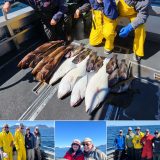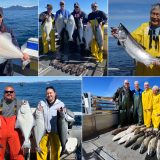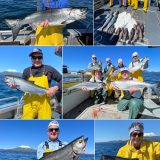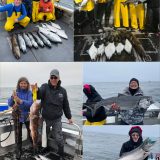Good news on the fishing front here in Sitka. Our boats have been bringing in a lot of very nice fish the past few days. There have been some full coolers hauled onto the dock and up to the processing room full of ocean bright king salmon (which have been showing good numbers this spring), halibut (including some over 100 pounds), some large canary rockfish, yellow eye rockfish and ling cod. Ling cod season is officially open until June 15th. Non-residents can catch and retain ling cod in the slot limit of 30-35 inches. You can also go for a trophy fish of 55 inches and up. It’s nice that you have an opportunity to retain really big ling cod and try to beat the world record, but it would take a massive fish. The current record weight of trophy-caught ling cod is 81 lbs. 6 oz.
The processing room is starting to get into full production as we have more of our boats going out now. There is a lot that goes on behind the scenes after the clients get off the boat and the day’s catch has been unloaded at the dock. Our head processor goes down to meet the boats on the dock, loads up the coolers, lunches, and bait coolers and hauls it up to our processing room (a.k.a. “PR”), adjacent to the cabin. From there, the processors and deckhands take each boat’s catch—by party—and fillet, section, wash, bag, vacuum pack, weigh and freeze all of the fish as efficiently as we can.
The seasoned veterans in the PR have the system down pat, but every year we have to teach the new guys how to do each step in the process. The hardest part is probably filleting a fish, which—if you’ve never done it before—can be a daunting task. Each type of fish requires a different technique to fillet it properly. Everybody has advice for the new guys, and it can be confusing. The best teacher is patience, a steady hand, and lots of practice.
I can remember facing my first “bomber bash” as a deckhand. I had it pretty easy compared to some of the other deckhands. I only had to fillet 15 black rockfish (a.k.a. “black bombers,” hence “bomber bash”) compared to the 36 that usually constitutes a bash for 6 fishermen. It took me a long time to get them filleted. It was a challenge; I was frustrated and sweating by the time I finished them. The results were acceptable, but not as clean as I knew they could be. However, it wasn’t long before I had a minor epiphany and understood the cuts necessary to efficiently separate edible flesh from the bone structure of the fish. Since then, filleting hasn’t been a problem, but getting to this point took a lot of practice and hard work.
The small bay just north of the lodge and adjacent to the cabin is probably one of the best spots to watch bald eagles in Sitka. After processing is done, I like to sit by the shore and see what the eagles are up to. Almost every day they gather around the bay, perching in the tall trees, on rocks, and even on rooftops. I’ve counted as many as twenty at one time around the bay, with eight in one tree alone.
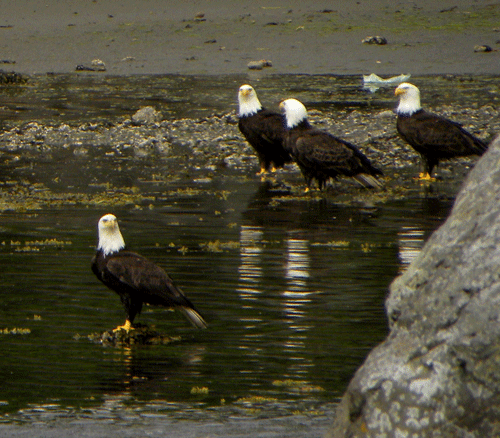
Bald Eagles Meeting
Eagles have excellent vision, easily spying the schools of herring and small perch that swim into the shallow bay to feed. They launch from the tree, swooping down with their talons outstretched and ready to grab the fish. They looks like jet fighters coming into land on an aircraft carrier, making slight adjustments to their flight pattern before they arc their bodies and stab into the water with their sharp talons, more often than not successfully nabbing the fish. Some of the eagles then fly off with their catch in their talons to their favorite roost to eat, while others make a mid-flight transition, taking the fish into their beaks before continuing on to the roost. It seems like they take turns on their “bombing runs,” but occasionally several eagles dive at the same time.

A bald eagle snatches a herring
I really like the eagles. I’ve always wanted to see eagles feed like this, and now I can watch them everyday. Years ago, we used to set out fish carcasses on the beach which would attract 20 to 40 eagles on a daily basis. This isn’t allowed anymore, because of the potential problems it caused, such as: eagles fighting with each other and one getting hurt inadvertantly, or sometimes the eagles would pick up the large carcasses, fly around, and drop them in people’s yards or in the ballfield creating unwanted litter.
So now the eagles use their talents to catch herring and perch the hard way in the bay during high tide. They do this more commonly in the spring and early summer. When the pink salmon start running up the local rivers and streams, the eagles follow them, and we don’t see them so much in the bay anymore. It makes sense; why bother catching a small seven inch herring or small perch when you can gorge on a fresh ten pound pink salmon?
Written by Tom, Deckhand ~ Checkmate

